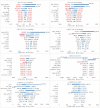Cost-effectiveness analysis of colonoscopy and fecal immunochemical testing for colorectal cancer screening in China
- PMID: 36033786
- PMCID: PMC9412186
- DOI: 10.3389/fpubh.2022.952378
Cost-effectiveness analysis of colonoscopy and fecal immunochemical testing for colorectal cancer screening in China
Abstract
Objective: This study aimed to evaluate the cost-effectiveness of the colorectal cancer screening in China, and that when the screening was implemented in a specific region.
Methods: A 13-state Markov model was established to compare four screening protocols, including annual fecal immunochemical testing (FIT1), biennial fecal immunochemical testing (FIT2), electronic colonoscopy every 10 years (e-CSPY10), and electronic colonoscopy every 5 years (e-CSPY5), with no screening from the perspective of Chinese healthcare system. The model simulated the health states of a cohort of 100,000 average-risk individuals aging from 50 to 75. Additionally, scenarios including the implementation in a specific region, starting from 40, and incompletely successful treatment of cancer were also analyzed.
Results: Annual and biennial FIT could save 8.13USD (US Dollar) and 44.96USD per person, and increase 0.0705QALYs (Quality-Adjusted Life Years) and 0.2341 QALYs compared with no screening, respectively. Annual FIT could decrease costs by 36.81USD per person and increase 0.1637 QALYs in comparison to biennial FIT. The results showed that both annual and biennial FIT for screening were dominant over no screening, and annual FIT was dominant over biennial FIT. The ICER (Incremental Cost-Effectiveness Ratio) for e-CSPY10 were 1183.51USD/QALY and 536.66USD/QALY compared with FIT1 and FIT2. The ICER for e-CSPY5 were 1158.16USD/QALY and 770.85USD/QALY compared with FIT1 and FIT2. And the ICER for e-CSPY5 relative to e-CSPY10 was 358.71USD/QALY. All the ICER values were lower than the economic threshold of 2021 Chinese GDP (Gross Domestic Product) per capita in 2021(12554.42USD).
Conclusions: It is worthwhile to popularize CRC screening in mainland China, as FIT always saving costs and colonoscopy is cost-effective. Regions with high income can take electronic colonoscopy every 10 years, or even every 5 years into consideration when determining the specific strategies.
Keywords: colorectal cancer; economic evaluation; electronic colonoscopy; fecal immunochemical testing; screening.
Copyright © 2022 Ren, Zhao, Zhou, Xing, Gong and Tang.
Conflict of interest statement
The authors declare that the research was conducted in the absence of any commercial or financial relationships that could be construed as a potential conflict of interest.
Figures





Similar articles
-
Cost-effectiveness and budget impact analyses of colorectal cancer screenings in a low- and middle-income country: example from Thailand.J Med Econ. 2019 Dec;22(12):1351-1361. doi: 10.1080/13696998.2019.1674065. Epub 2019 Oct 12. J Med Econ. 2019. PMID: 31560247
-
Health benefits and cost-effectiveness of a hybrid screening strategy for colorectal cancer.Clin Gastroenterol Hepatol. 2013 Sep;11(9):1158-66. doi: 10.1016/j.cgh.2013.03.013. Epub 2013 Mar 28. Clin Gastroenterol Hepatol. 2013. PMID: 23542330
-
Cost-effectiveness simulation and analysis of colorectal cancer screening in Hong Kong Chinese population: comparison amongst colonoscopy, guaiac and immunologic fecal occult blood testing.BMC Cancer. 2015 Oct 15;15:705. doi: 10.1186/s12885-015-1730-y. BMC Cancer. 2015. PMID: 26471036 Free PMC article. Clinical Trial.
-
Efficacy and cost-effectiveness of fecal immunochemical test versus colonoscopy in colorectal cancer screening: a systematic review and meta-analysis.Gastrointest Endosc. 2020 Mar;91(3):684-697.e15. doi: 10.1016/j.gie.2019.11.035. Epub 2019 Nov 30. Gastrointest Endosc. 2020. PMID: 31790657
-
Cost-Effectiveness of Colorectal Cancer Screening Strategies-A Systematic Review.Clin Gastroenterol Hepatol. 2019 Sep;17(10):1969-1981.e15. doi: 10.1016/j.cgh.2019.01.014. Epub 2019 Jan 16. Clin Gastroenterol Hepatol. 2019. PMID: 30659991
Cited by
-
Cost-Utility Analysis for Colorectal Cancer Screening According to the Initiating Age of National Cancer Screening Program in Korea.J Korean Med Sci. 2024 Mar 18;39(10):e98. doi: 10.3346/jkms.2024.39.e98. J Korean Med Sci. 2024. PMID: 38501184 Free PMC article.
-
Clinical diagnostic value of methylated SEPT9 combined with NLR, PLR and LMR in colorectal cancer.BMC Gastroenterol. 2024 Jul 29;24(1):240. doi: 10.1186/s12876-024-03332-6. BMC Gastroenterol. 2024. PMID: 39075402 Free PMC article.
-
Artificial intelligence in colonoscopy: from detection to diagnosis.Korean J Intern Med. 2024 Jul;39(4):555-562. doi: 10.3904/kjim.2023.332. Epub 2024 May 2. Korean J Intern Med. 2024. PMID: 38695105 Free PMC article. Review.
-
Evaluation of long-term benefits and cost-effectiveness of nation-wide colorectal cancer screening strategies in China in 2020-2060: a modelling analysis.Lancet Reg Health West Pac. 2024 Aug 19;51:101172. doi: 10.1016/j.lanwpc.2024.101172. eCollection 2024 Oct. Lancet Reg Health West Pac. 2024. PMID: 39247209 Free PMC article.
-
Diagnostic value of human fecal SDC2 gene in colorectal cancer.Am J Transl Res. 2023 Apr 15;15(4):2843-2849. eCollection 2023. Am J Transl Res. 2023. PMID: 37193183 Free PMC article.
References
-
- Jie H. editor. China cancer registry annual report. Beijing: People's Medical Publishing House; (2019).
Publication types
MeSH terms
LinkOut - more resources
Full Text Sources
Medical

